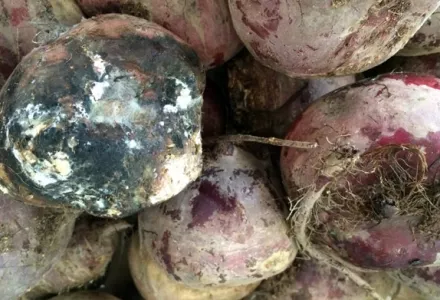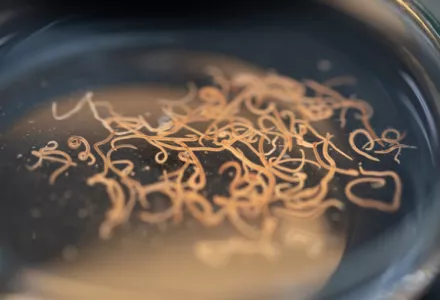Plague. The word conjures up visions of rats crawling with fleas ready to leap on unsuspecting humans to infect them with the deadly plague bacteria yersinia pestis. Perhaps it brings to mind swarms of locusts, blotting out the sunlight and intent on devouring everything in their path. But those are not the only kinds of plagues, as anyone whose well-tended garden has been devastated by the sudden appearance of a much-dreaded pathogen can attest.
Plants have many enemies ranging from worms and insects that are visible to the naked eye, to microscopic single-celled organisms and non-cellular pathogens that are only visible under powerful electron microscopes. These agents of horticultural disease may be small, but they can have an enormous effect. They twist plants into tortured shapes, turn them ugly shades of brown and cause billions of dollars of economic damage every year.
Although insects are a major concern to growers, they are biologically quite different from agents of infectious plant diseases. Insects are multicellular animals, exhibiting levels of complexity and behaviour far beyond those seen in other less noticeable pests. Thrips, flies, aphids and other insects or mites may be spotted by inspecting plants carefully before they do significant damage. Other threats are more insidious and often remain unnoticed until the damage is well underway. Exactly what threats are these? They are bacteria, fungi, protists and viruses.
Bacteria
Life on Earth can be broadly divided into two major branches:
- Eukaryotes
- Prokaryotes (see Table 1).
Bacteria are prokaryotes and they differ from eukaryotes (such as protists, fungi, plants, and animals) in a number of important ways. Bacterial cells are smaller, have free-floating genetic material (DNA) within their cells, and are much simpler in their internal organization and structure.
Bacteria are found in virtually every imaginable habitat and what they lack in complexity, they make up for in sheer numbers. A single gram of soil can contain more than a billion individual bacteria and thousands of different species. The exact number of bacterial species is unknown, but it is surely in the tens of thousands (at least!).
Bacteria resistance and bacterial infection
As far as plants go, most bacteria are completely harmless and some are beneficial. In the case of legumes (members of the pea family), nitrogen-fixing bacteria live in the plants’ root nodules where they provide a ready supply of nitrogen that would not otherwise be available from the soil.
Although fungi and viruses are more common agents of plant diseases, bacteria also cause their share of problems. Healthy crops are generally quite resistant to attack from bacteria, but plants suffering from other diseases or that are in a poor state of health are more susceptible. Injured plants can be colonized by bacteria that find their way into plant tissues through wounds.
The symptoms of bacterial infection can be mistaken for other infections, especially at an early phase. Typical symptoms include discolouration or spots on plant parts. When things get really bad, the infected tissues become soft and may even melt into a blackened or oozing slimy mess. Blossom end rot is a bacterial disease of some fruit-bearing species in which the fruit develop soft black lesions at the part of the fruit where the flower formed. Not a pretty sight.
In theory, plants can be treated with antibiotics to control bacterial diseases, but in practice it is usually best to cut away affected parts, or completely remove infected plants, and hope for the best.
Figure 1:

Fungi
Fungi - like plants, protists and animals - are eukaryotes. Compared to bacteria, fungi have a much more complex cellular structure and organization. The fungal kingdom is quite diverse and includes yeasts, moulds and mushrooms. Fungi reproduce asexually by generating large masses of spores through cell division (mitosis). Sexual reproduction is also common with two compatible mating types fusing to undergo meiosis and produce reproductive spores possessing a combination of traits derived from each of the parents.
Yeasts grow as single cells or small clumps of connected cells. Moulds and mushrooms have cells called hyphae, which are thin and cylindrical and grow from their tips to explore the environment to seek out nutrients. Although individual fungal cells are microscopic, fungal colonies are often visible as a large mass of hyphae called a mycelium.
Turning over a rotting log in the woods often reveals white, fuzzy wisps of mycelium. Most people are familiar with mould fungi. They can be found growing on food or other decomposing material. Moulds are remarkable because of the colourful asexual spores that they produce on top of the growing mycelium. Mould spores come in many colours including shades of brown, black, green, blue, yellow, purple and even red. The overwhelming majority of fungi live as saprophytes, which means they obtain their nutrients from dead organic matter. Along with bacteria, fungi perform a critical role in the environment as they break down and recycle organic matter.
Beneficial fungi
Some fungi are beneficial to plants. For example, a mycorrhiza is a symbiotic relationship between a fungus and the roots of a plant. The fungus provides mineral nutrients for the plant and the plant provides carbon compounds produced by photosynthesis for the fungus. Most plants on Earth engage in this mutually beneficial relationship.
Unfortunately for both animals and plants, some fungi are parasitic. Fungal infections are particularly troublesome because fungal cells are similar in many ways to those of other eukaryotes (such as plants), which makes it a challenge to find treatments to attack the fungus selectively, without also causing harm to the host. Despite this, much research has been devoted to combating plant fungal diseases and options exist for most commonly encountered fungi.
Figure 2:

Like bacteria (and viruses too), fungi can find their way into a host plant through wounds. They can also attack plants directly by using special hyphae to penetrate healthy tissues. There are thousands of different plant diseases caused by fungi including rusts, smuts, blights, damping- off disease, and root, stem and fruit rots.
Defence against fungi
The first line of defence against fungi is the use of disease-resistant cultivars. Selective breeding, and in some cases genetic engineering, has led to resistant strains of many economically important crop species. Even so, resistant strains are not always available and resistance does not imply immunity. Preventive treatment with fungicides is costly and often effective but the environmental soundness of this practice is questionable. Despite growers’ best efforts, fungal diseases persist and new or previously unknown strains of fungal pathogens continue to appear.
Treatment options for fungal diseases include cutting off diseased parts or removing infected plants. Culled plants can be burned or wrapped in plastic and disposed of as trash. Natural anti-fungal treatments include solutions of copper and/or sulphur or hydrogen peroxide. Many ‘home remedies’ such as garlic or horseradish are of questionable value (but they might work in certain cases). If you try cutting back infected parts, removing infected plants completely, or using organic treatment methods, and none of this stems the tide of fungal destruction, commercial fungicides tailored for specific plant-fungus combinations are available. These chemicals should only be used in accordance with the manufacturer’s instructions.
Much can be done to discourage the appearance of fungal infections in a crop. Proper air circulation, humidity control, and appropriate irrigation strategies will go a long way toward keeping plants healthy.
Protists
Protists differ from plants and fungi in that they are able to move actively in the environment by crawling or swimming with the use of flagella or cilia (fine hair like structures that act like tiny oars). These organisms include what many people still call ‘single-celled animals’ and include genera such as Paramecium, Euglena and various kinds of amoebas. Protists are truly weird creatures with some species exhibiting characteristics of plants, animals or fungi at different times during their life cycles.
As far as plant diseases go, it is the ‘fungus-like protists’ that are of greatest concern. This includes species that were once classified with the fungi because they grow and look like fungi. The infamous Irish Potato Famine (1845- 49) resulted from a widespread and devastating potato blight caused by the protist Phytophthora infestans. Other phytopathogenic protists include members of the genus Pythium, which cause root rot, and organisms such as Plasmopora that cause downy mildews.
How to keep protists away
The best treatment is the immediate removal of the infected individuals. Spraying susceptible crops with Bordeaux mixture (a solution of copper sulphate and lime) helps to prevent infection. Downy mildews and blights caused by fungus-like protists can also be treated with neem oil, peroxides, and bicarbonate (baking soda) based solutions. Bio-control organisms such as the bacteria Bacillus subtilis may be effective in treating diseases caused by both fungi and fungus-like protists.
Table 1. Comparison of eukaryotes, prokaryotes and viruses
| EUKARYOTES | PROKARYOTES | VIRUSES | |
|---|---|---|---|
| Types of organisms | Plants, animals, fungi, protists | bacteria, archaea | Non-cellular |
| Cells | large | small | no |
| Genetic Material | Linear DNA molecules in nucleus | Circular DNA free floating in cell | Small amount of DNA or RNA |
| Cell Wall | Present in plants, fungi, and fungal-like protists |
present | no |
| Motility (ability to move) | Protists and animals only | some | no |
| Photosynthesis | plants and some protists only | some | no |
| Diverse Organelles in Cells | yes | Less so | no |
| Reproduction | Asexual and sexual | Essentially asexual only | Requires host cell |
Viruses
In many ways, viruses are the odd organisms. In fact, there are those who do not consider viruses to be living organisms at all. However, the more we learn about the molecular biology of viruses, the more it seems that they should be considered “alive” in the most fundamental sense. Unlike the disease agents discussed so far, viruses do not have cells. They do not move, have no metabolism, and do not require a source of “food” to survive. Outside of a host, some viruses can be crystallized and stored in a jar on a shelf as if they were just some purified chemical awaiting use in a lab experiment. Under certain specific conditions, however, they are quite efficient at one particularly important aspect of life - reproduction.
A typical virus consists of a protein coat or outer shell that encloses and protects a small amount of genetic material. Viruses possess just enough genetic material to perform a few basic functions. Viruses are parasites that require a host cell to reproduce. They rely on their ability to hijack and reprogram the molecular machinery of their cellular victims to do most of the work for them.
Viruses are seldom a major problem in naturally occurring plant populations where there is a diverse range of species. In crop systems, they are presented with a large number of individuals of the Essentially asexual only-same species, often in dense populations. This is an ideal situation for a virus that finds itself in the right place. Viruses are seldom lethal to plants, but they reduce productivity and cause appearance problems that seriously damage the economic value of a crop. Virus diseases in lettuce, tomato, cucumber and many other plants are a concern and generally manifest themselves as a yellowing or spotting of leaves and stems, curling of leaves, or abnormal fruit development.
Virus control
Viruses may enter plants through wounds or they can be transmitted by insects, nematodes or mites. Controlling these vector organisms is an important preventive measure. Since viruses are not based on any form of cellular organization like that of other plant pathogens, few treatment options exist. Chemicals simply do not work. As usual, infected plants should be removed. Since chemical treatments are not a viable option, much work has been done to produce virus resistant cultivars and these should always be chosen if available.
It’s a tough world out there for plants, and humans have made it even tougher by growing plants in mono-culture, packed together in as little space as possible, and in the same location year after year. This presents an ideal situation for persistent plant pathogens to gain a foothold and keep coming back. By rotating crops, ensuring the best possible environmental conditions, using disease resistant cultivars, and occasionally and judiciously applying chemical treatments when necessary, growing success can be achieved.



















